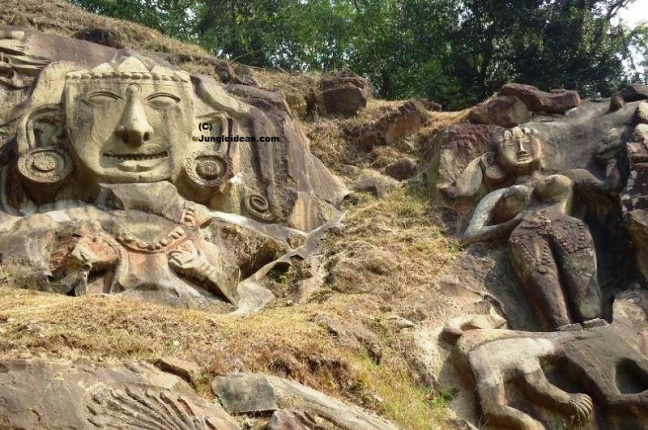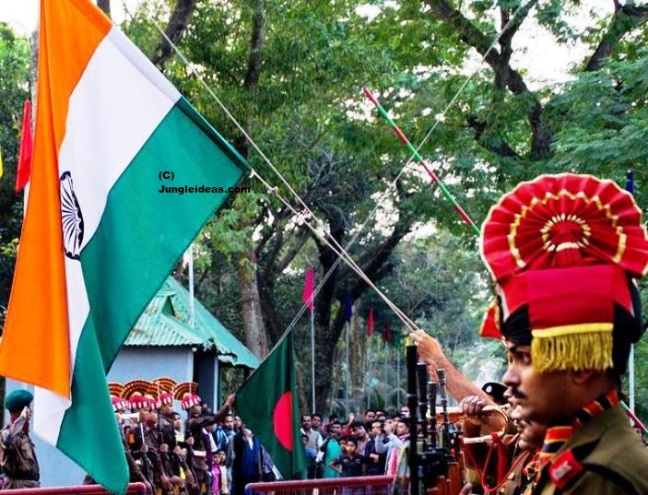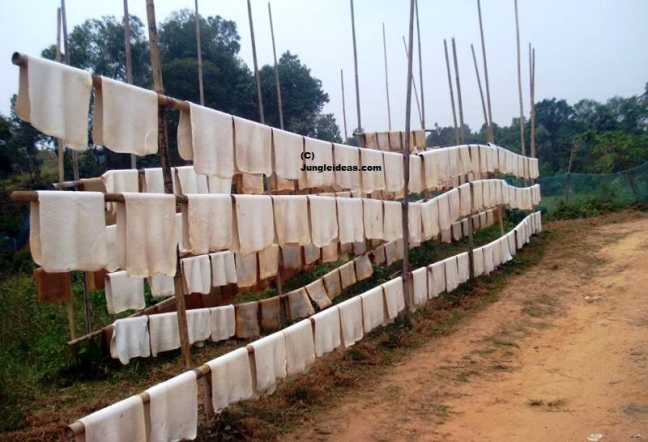One among the Seven Sister States of India, Tripura is the third smallest state in the country located in the North East of India. The State of Tripura is bordered by Bangladesh to the north, south, and west, and the Indian states of Assam and Mizoram to the east. Five mountain ranges—Boromura, Atharamura, Longtharai, Shakhan and Jampui Hills—run north to south, with intervening valleys; Agartala, the capital, is located on a plain to the west. Tripura receives seasonal heavy rains from the south west monsoon. Forests cover more than half of the area, in which bamboo and cane tracts are common. The State of Tripura has the highest number of primate species found in any Indian state. Most residents are involved in agriculture and allied activities, although the service sector is the largest contributor to the state’s gross domestic product. Tripura is virtually embraced by Bangladesh with which it shares strong ties before India’s partition. The name of the State has been derived from ‘Tripura Sundari’ the presiding deity of the land. This erstwhile princely state was ruled by maharajas of the Manikya dynasty. Tripura was an independent administrative unit even during the reign of the British Raj. Tripura is delicately beautiful! It has many rulers left behind an imposing legacy of fine palaces that are set up against an unspoilt idyllic landscape. Its Hindu and Buddhist monuments, its protected forests and the plethora of cultural experiences that greet the first time visitor make it a sought after tourist destination.
Mainstream Indian cultural elements, especially from Bengali culture, coexist with traditional practices of the ethnic groups, such as various dances to celebrate religious occasions, weddings and festivities; the use of locally crafted musical instruments and clothes; and the worship of regional deities. The sculptures at the archaeological sites Unakoti, Pilak and Devtamura provide historical evidence of artistic fusion between organised and tribal religions. The Ujjayanta Palace in Agartala was the former royal abode of the Tripuri king. The Ujjayanta Palace is a magnificent royal house built by Maharaja Radha Kishore Manikya in 1901. Across Agartala, other places worthy of visit are the Kamalasagar (16th century Kali Temple) and Dumboor Lake (most popular picnic spot and home for various migratory birds). In Udaipur, the Neermahal Water Palace is a spectacular monument built by Maharaja Bir Bikram Kishore Manikya in the center of the Rudrasagar lake. Bhuvaneshwari Temple (built by Maharaja Govinda Manikya on the bank of Gomati at Udaipur) and Tripurasundari temple (also known as Kurma Pitha and is one among the holiest ‘Shaktipeeths’ worshipping Goddess Parvati) are worth visiting. Pilak is famous for its archaeological relics and the Buddhist site of Mahamuni. Besides Pilak, places of archaeological importance in Tripura are Unakoti, Betamura (Chabi Mura), Boxnagar and Gunabati Group of Temples.
Tourism has emerged as one of the most important segments of the economy of Tripura as well as North East India. North East India being blessed with the bounties of Mother Nature and unadulterated with the Rapid globalization of the World economy has a prime potential for Tourism. Tourism has helped in the improvement in the standard of living of people of Tripura as well as other North East Indian States. Endowed with rich variety of tourist attractions consisting of archaeological monuments, palaces, water bodies, temples, mosques & Buddhist Stupas of religious significance, forest and wild life, traditional craftsmanship, rich cultural diversity, Tripura offers vast potential for growth of Tourism. Return of peace in the state and proximity with Bangladesh provide highly advantageous conditions for development of tourism in the state. As a result the inflows of tourist traffic both domestic and foreign are increasing day by day. Tripura has taken a comprehensive plan for promotion of Tourism in the state, which includes among other things augmenting accommodation facilities, improving the existing infrastructure and attraction at major tourist destinations, developing the communication network and strengthening the skill of the manpower engaged in this sector.
Fairs and Festivals of Tripura ~
Tripura celebrates some of very spectacular festivals. Teh Kharchi Festival (July) is celebrated by both tribal and non-tribal communities, the entire pantheon of Hindu Goddesses are invoked as a part of this ritual. It is a week long festival which is celebrated at ‘Chaturdasha Devta’ Temple. This festival is followed by Ker Puja, which is generally after 15 days of the Kharchi Puja in Tripura. It is performed by the royal people of Tripura for the welfare of the people. The Gomti River becomes a focal point of the Uttarayan Sankranti and thousands gather on its banks for a holy dip. A two day long fair is held at a place called Tirtha Mukh near the river. The Orange Harvest Festival (November) celebrates the orange harvest season in the Jampui hill district of Tripura.
Cuisine of Tripura ~
Tripura has preserved its culinary culture and has a diversified food. The people of Tripura are mostly non vegetarians and their food mostly includes ‘Berma’ which is a type of fermented fish. The food of the people of Tripura include all types of meat like pork, mutton, chicken, turtle, beef, crabs, fish and prawns, The traditional cuisine of Tripura is known as Mui Borok.
Places of Interest at Tripura ~
1| Unakoti

Located at around 178 km. from the capital city of Agartala, Unakoti has beautiful rock cut carvings and stone images which are huge in size and made on vertical walls exposed in the open atmosphere.
Unakoti is a ‘Shaiba’ (Saivite) pilgrimage and dates back to 7th – 9th centuries if not earlier.The marvelous rock carvings, murals with their primitive beauty, waterfalls are not to be missed. Unakoti means one less than a crore and it is said that these many rock cut carvings are available here. As per Hindu mythology, when Lord Shiva was going to Kashi along with one crore gods and goddesses he made a night halt at this location. He asked all the gods and goddesses to wake up before sun rise and proceed for Kashi.
It is said that in the morning, except Shiva himself, no one else could get up so Lord Shiva set out for Kashi himself cursing the others to become stone images. As a result we have one less than a crore stone images and carvings at Unakoti.These carvings are located at a beautifully landscaped forest area with green vegetation all around which add to the beauty of the carvings.The images found at Unakoti are of two types, namely rock-carved figures and stone images.
Among the rock cut carvings, the central Shiva head and gigantic Ganesha figures deserve special mention. The central Shiva head known as ‘Unakotiswara Kal Bhairava’ is about 30 feet high including an embroidered head-dress which itself is 10 feet high. On each side of the head-dress of the central Shiva, there are two full size female figures – one of Durga standing on a lion and another female figure on the other side. In addition three enormous images of Nandi Bull are found half buried in the ground. There are various other stone as well as rock cut images at Unakoti. Every year a big fair popularly known as ‘Ashokastami Mela’ is held in the month of April which is visited by thousands of pilgrims from North East India and other parts of the country.
2| Ujjayanta Palace ~
Located at the heart of the capital city of Agartala, the Ujjayanta Palace is a royal house that was built by Maharaja Radha Kishore Manikya during 1899-1901.
It is a two storied mansion, having a mixed type of architecture with three high domes, the central one being 86’ high.
The magnificent tile floor, curved wooden ceiling and beautifully crafted doors are particularly notable. The palace is set with huge Mughal style gardens, beautified by pools and gardens. Flood lighting and fountains have also added to its beauty.
3| The Border of India and Bangaldesh ~

Tripura shares the longest border with Bangladesh among all the other North East India States and hence a regular Border patrol is a common sight at Tripura. Every day a grand ceremony similar to the Wagah Border takes place at the Border of India and Bangladesh at Agartala. Tourist visit the border to catch a glimpse of the grand march of the troops of India and Bangladesh and admire the valor of the troops.
4| Neer Mahal Palace ~

Neermahal Palace is a former royal palace built by King Bir Bikram Kishore Debbarman of the erstwhile Kingdom of Tripura in the middle of the lake Rudrasagar in 1930 and was completed by 1938. It is situated in Melaghar, 53 kilometers away from the Agartala, the capital of Tripura. The palace is situated in the middle of Rudrasagar Lake and assimilates Hindu and Muslim architectural styles.
The palace is the largest of its kind in India and the only one in Eastern India. There are only two water palace in India another one is the Jal Mahal in Rajasthan.
Known as ‘lake palace’ of Tripura, Neer-Mahal was constructed as a summer residence. It was Maharaja Bir Bikram Manikya Bahadur’s idea to build a palace in the beautiful Rudrasagar lake and in 1921 he accredited the British company Martin and Burns to construct the palace for him. The palace is the establishment of Maharaja’s great taste and his fascinating idea of blending Hindu and Muslim traditions and cultures.
The palace is divided into two parts. The western side of the palace is known as Andar Mahal. It was made for the royal family. The eastern side is an open-air theater where drama, theater, dance and other cultural events were organized for the enjoyment of Maharajas and their royal families. The palace has 24 rooms in total.
Neer-Mahal has two stairways inside leading down to a landing on the water of Rudrasagar Lake. Maharajas used to go by motor boat to the palace from ‘Rajghat’.

-
5| The Tripura Sundari Temple ~
The Tripura Sundari Temple is one of the 51 Shakti Peethas in India.
As per Hindu Mythlogy, Lord Vishnu had cut off the body of Mata Sati into 51 pieces with his ‘Sudarshana Chakra’ and all these pieces fell at different places throughout the country and these places are known as ‘Shaktipeeths’. It is said that ‘right foot’ of Mata Sati fell at Matabari on the southwestern outskirts of Udaipur town. This ‘pithasthan’ (centre of pilgrimage) is also known as Kurma Pith because the shape of the temple premises resembles that of “Kurma” or tortoise. The idol of ‘Maa Kali’, presiding deity of the temple, stands in the sanctum and it is made of reddish black stone, popularly known in Bengali as ‘Kashtipathar’.
The Goddess ‘Kali’ is worshipped in her incarnation as ‘Shoroshi’ (sixteen year old girl) in the temple by professional priests. An idol of smaller size of Maa Kali called ‘Chotto Maa’ who stands beside the presiding deity used to be reportedly carried along by the kings during hunting expeditions and also during war for impromptu worship in tents. The temple consists of square type sanctum of the typical Bengali hut structure with a conical dome. The temple was constructed in 1501 A.D. by the then Maharaja Dhanya Manikya.In the eastern side of the temple there is the famous ‘Kalyan Sagar’ lake where fishes and tortoises of huge size are found and devotees feed them with “Muri” (puffed rice) and biscuits. No fishing is permitted in the Kalyan Sagar.Every year on ‘Diwali’, a famous ‘Mela’ or fair takes place near the temple which is visited by more than two lakh pilgrims.
6| The Rubber Plantations of Tripura ~

Tripura ranks second in rubber production of India, next to Kerala. The quality of rubber produced in Tripura is superior. Rubber (Heave brasiliensis) plantation was introduced in this state on a trial basis by the forest department, Tripura Government in 1963.
A Large part of the Area in Tripura is surrounded by Rubber Plantations that has provided the indigenous Tribes of Tripura with enormous employment opportunities. The starting of rubber production, helped most of the the tribals with employment opportunities. Government has developed many rehabilitation projects for the tribes who shifted from “Jhoom cultivation” or shifting cultivation. Tripura Forest Development and Plantation Corporation Limited (TFDPC) encouraged the poor and illiterate workers or tribes to come forward and work in the latex productions. The local people were trained for the plantation work and given them the knowledge of how the business of rubber will help them. These people were provided with food, clothes and shelter also by the Government. Hence it improved the economic status of localities.
7| The Border Bazaar at Agartala

One in every week locals from India and Bangladesh gather at the Border Haat or Market at Agartala and indulge in business across the borders. Goods from both countries are brought and a traded here.
8| The State of Tripura also has a total of 2 Nos. of National Parks and 4 Nos. of Wildlife Sanctuaries with a varied species of Flora and Fauna ~
The 2 National Parks of Tripura are ~
- Clouded Leopard National Park
- Rajbari National Park
The 4 Wildlife Sanctuaries of Tripura are ~
- Gumti Wildlife Sanctuary
- Rowa Wildlife Sanctuary
- Sepahijala Wildlife Sanctuary
- Trishna Wildlife Sanctuary





